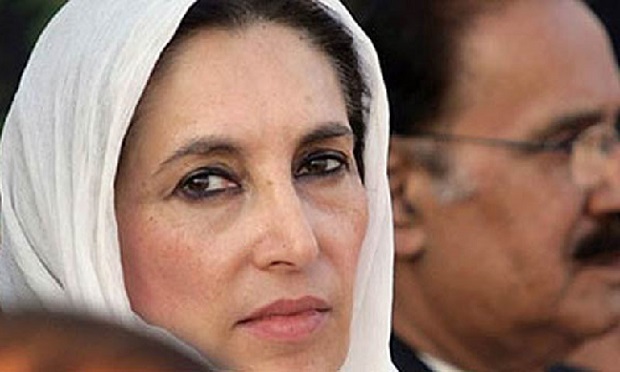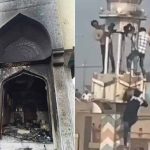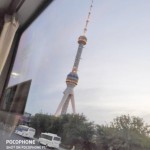By Tariq Majeed
The facts and quotes concerning Benazir’s assassination are from the report of the UN Commission of Inquiry as published by the NEWS online on 17 April 2010, and those concerning the C-130 Crash are from Masterminds of Air Massacres of August 17 in Pakistan, September 11 in America, Baitul Hikmat, Lahore, 2006.
The clues to Benazir’s assassination were not far to seek, were the UN inquiry honest, and insightful. There is also the history of such assassinations in Pakistan to learn from. With the requisite effort by competent Pakistani investigators such an inquiry would surely uncover not only the local elements involved in the atrocious crime but also the real perpetrators the masterminds.
The parallel case to learn from is the assassination of General Zia ul Haq in the 1988 C-130 crash that killed also 30 other persons. Only the method of killing was different in the two cases, otherwise the similarities between them are strikingly close.
Ensuring the crucial key move
General Zia did not want to go to Bahawalpur to watch the M1A1 tank demonstration. But the scheme to kill him hinged on his taking the trip. The master schemers had to ensure he would board the C-130 flight.
Their primary tool for this purpose was Major General Mahmud Ali Durrani who, as commander of the armoured division conducting the demonstration, would be General Zia’s host. Durrani had been Zia’s military secretary and was close to him and his family. His persistent telephone calls made Zia reluctantly agree to take the trip.
But to the meticulous schemers one persuader was not enough. They had fixed up an additional agent to ensure Zia will undertake the trip, and had arranged for Ambassador Arnold Raphael to be Zia’s companion on the trip.
Raphael was on close informal terms with Zia since 1975 when he used to be the senior political officer in the US embassy in Islamabad and General Zia was the Army Chief. Learning that Raphael would be on the flight, Zia approved his own travel plan, and sealed his fate.
Now see the similarity
The scheme to kill Benazir hinged on her standing up in the vehicle with her head outside the escape hatch when her vehicle, on departing from Liaquat Bagh, would be near the chosen murder point. If she didn’t show up from the hatch, this scheme would fail.
The schemers must have had alternative plans but that would be for another time and another place, whereas it was critical for the full success of their scheme that she be killed at the programmed time and place.
They had arranged that at the programmed time someone close to Benazir would call by cell phone and plead that she show herself up from the hatch and wave to her admirers around her vehicle.
They knew her personal protection officer, SSP Major (R) Imtiaz Hussain, had been advising her not to expose herself through the hatch to wave to the crowds. So, they had arranged for an additional powerful incentive to urge her to wave to the crowd.
As her vehicle neared the murder point a bunch of people carrying PPP flags and shouting slogans in her praise came surging toward her Land Cruiser, forcing it to halt. With them was a PPP political figure, who had become a kind of an icon as he had lost both legs in a bomb blast at a PPP function.
The mysterious cell phone caller apparently drew Benazir’s attention to this special group of her devotees while asking her to respond to their cheers. She stood up through the hatch and the terrorist with the pistol and explosives and the hidden sniper with the laser gun or other skull-smashing ammunition were ready for this moment.
It is absurd to think that the schemers committed to killing Benazir, for which they had made an elaborate plan, would leave it to a chance of her hitting the escape hatch lever and getting killed. The culprit who arranged the fatal phone call to Benazir, and the one who organized the bunch that halted her vehicle can be traced out quickly.
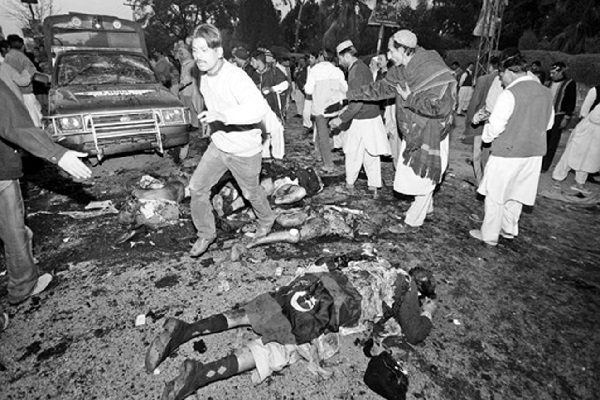
Swift sweeping of the crime site
The site of the C-130 crash was swiftly swept off. The crash, occurring on 17 August 1988 afternoon, was followed by a big fire that burnt for hours. The PAF investigation team reached the spot at 7 am on the 18th.
One of its members later disclosed that he was amazed to see thousands of footprints on the site, and that army men had been searching through the debris during the night and had taken away the passengers’ belongings and many other items from the site. The hurried search and sweep operation at the C-130 crash site immediately gave a lead toward solving the crash mystery.
The crime scene where Benazir and 24 other persons were killed and 91 injured on 27 December was swept clean even more rapidly. In less than two hours the SP on duty ordered the Fire Fighters to wash the crime scene down with fire hoses.
The UN Inquiry Commission and other commentators have lamented that washing down the crime scene had wiped out many important pieces of evidence.
Actually, the action of hastily cleaning up the site straightaway established a lead to the perpetrators, because this action originated from them or their local front-men. It shouldn’t take a couple of tough investigators long to find out who initiated the command to hose down the murder site.
Preventing post-mortem
The pathologist at CMH Bahawalpur had begun post-mortem on the bodies or body parts of the casualties of the C-130 crash, when the CMH received orders to stop the examination. Obviously, the orders had originated from a high authority. Post-mortem would have identified the gas and the explosives used in the sabotage. This was another sure clue for the investigators.
The issue of post-mortem of Bhutto’s remains was surrounded by confusion, to which the UN Commission of Inquiry added liberally. It was said that the CPO Rawalpindi refused permission to the doctors at the Rawalpindi General Hospital(RGH) to perform post-mortem.
The CPO denied it. Newspapers on 28 December reported that in fact post-mortem was forbidden by Benazir’s husband Asif Ali Zardari. The UN report tried to deflect the blame from Zardari. Confusion aside, the fact stands that post-mortem on Benazir’s remains was not performed. This was a part of the scheme to hide the real cause of her death.
Back-up transport absent when required
As a rule, two C130 planes were made ready for General Zia’s air journeys. Which of the two planes would he take for the journey remained a secret till the time of his departure? For his departure from Bahawalpur on 17 August 1988, however, the stand-by plane was absent; it had remained back at Chaklala air base, Rawalpindi, because the Bahawalpur airport was too small to accommodate two C-130s.
This was, of course, a pre-planned plot by the schemers of his assassination, to ensure that on departing from Bahawalpur General Zia would have no choice but to board the C-130 by which he had come and in which all the apparatus for sabotage had been set up.
For Benazir’s road travels there was always a back-up armoured car to be used as a decoy and an alternative transport in emergency. For the trip to Liaquat Bagh, the venue of her public function, the back-up car was a bullet-proof black Mercedes-Benz which normally came at the end of her convoy of vehicles. Its occupants, besides the driver and Lt-General (retd) Tauqir Zia, were PPP’s Faratullah Babar, Babar Awan, and Rehman Malik.
Those who accompanied Ms Bhutto in the Land Cruiser were driver Javedur Rehman, SSP Major (retd) Imtiaz Hussain, senior PPP member Makhdoom Amin Fahim, Benazir’s political secretary Ms Naheed Khan, Senator Safdar Abbasi, Benazir’s personal security in charge Khalid Shahenshah and her attendant Razaq Mirani.
When the function ended just after 5 pm and Ms Bhutto entered her Land Cruiser, the Back-up Mercedes moved to depart. It was the first to leave the parking area. It was far from the Land Cruiser when the attack took place. Later it was reported that its occupants drove all the way to Zardari House, a drive of about 20 minutes, before they became aware that Ms Bhutto had been injured in the blast!
With Ms Bhutto unconscious and bleeding profusely, the driver was told to rush to RGH. Now was the Back-up Mercedes needed, but it was nowhere to be seen. All the four tires of the Land Cruiser were punctured by the blast. The Land Cruiser travelled some distance, and then stalled. The distressed party had to wait till a PPP member’s car arrived and took Ms Bhutto to the hospital.
As it turned out, when Benazir was brought to the hospital she was lifeless. But, had she been still breathing after the attack and was immediately transferred to the Back-up car and rushed to hospital where the doctors could save her, then what! The schemers could not let that happen. So their script for the event laid down that the Back-up car be absent before the occurrence of the attack. Isn’t it clear to whom is this clue pointing?
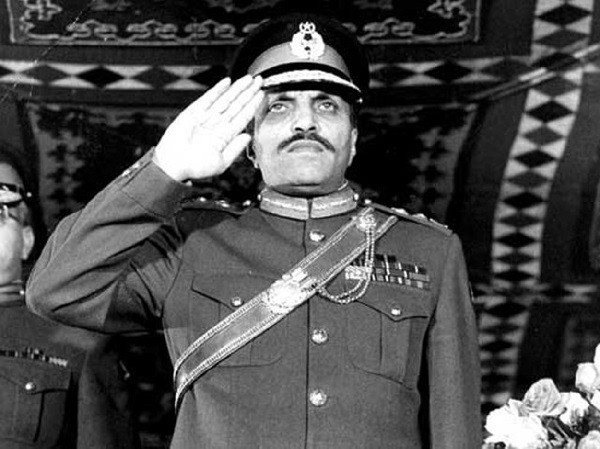
Close colleagues collaborated in the crime
This similarity in the two mega – crimes is disturbing. The local tools used by the masterminds to carry out key roles in both assassinations belonged to the inner circle of colleagues or associates of the victim in each case. The persons who executed the brutal scheme of destroying the C-130 belonged to General Zia’s own ‘party ‘the military.
Some of the collaborators in the cover-up belonging to the civil administration were his own men; one of them became the acting President following President Zia’s death. Most of those who were active in the crime or its cover-up have been identified elsewhere.
Among those who performed the key tasks in Ms Bhutto’s assassination were persons from the leading ranks of her own party the PPP who were thought to be loyal to her. Reports about their identification have appeared in the media. They can be pinpointed by formal investigation.
No full investigation as yetin both cases
Both cases suffer from a common blight denial of a full investigation. Ms Bhutto’s murder investigation makes a disgraceful story that has yet to reach its end. All the efforts toward investigation were half-hearted and unfinished and in one case blatantly misplaced.
A Joint Investigation Team (JIT) under AIG Punjab Police, formed on 28 December 2007, wound up on 17 February 2008 with futile findings. A second JIT led by the Federal Investigative Agency (FIA) was formed in October 2009; 18 months after Mr Zardari took hold of the reins of government. This JIT, reportedly, is still struggling with the case!
All this effort, anyway, was no match to the UN Commission of Inquiry, in waste of funds and time and uselessness of results. Its report came out on 16 April 2010. The main finding, along with the part quoted above, said that now “Pakistani authorities [should] carry out a serious, credible criminal investigation” into the case!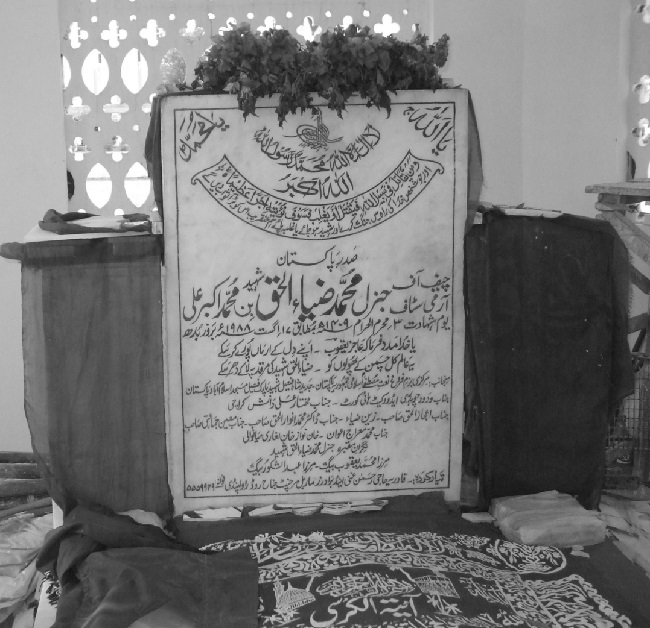
The case is going the way the C-130 inquiry took! In the C-130 case a PAF technical inquiry was ordered on the same day after the crash. In its report released on 16 October 1988, it established sabotage as the cause, and recommended a full inquiry into the crash. Neither the air force nor the army ordered a full inquiry.
The Interior Ministry ordered an inquiry on 10 September 1988 with the approval of acting President Ghulam Ishaq Khan. The team consisting of officers of FIA, Police and the Intelligence Bureau had a civil servant, F.K. Bandial, as a special coordinator. This inquiry’s results remained unpublished. The crash became a closed case during Ms Bhutto’s regime, formed after the November 1988 elections.
In November 1990, Muslim League’s Nawaz Sharif came to power and, under public pressure, established a commission of inquiry led by Justice Shafiur Rehman in August 1992. The commission’s report finalized in 1995 remained unpublished, but a local magazine found a leak. The commission started off well but left the matter half way, recommending that FIA should carry out the full inquiry!
The report had a valuable plus point. It identified, though sheepishly, the Masterminds. The Commission derived this finding from the Hearings before the Subcommittee on Crime of the Committee on the Judiciary, US House of Representatives, 101st Congress, held in 1989. The Hearings let it known that removal of Ziaul Haq served the US aim of bringing democracy in Pakistan.
The same masterminds for both crimes
The close similarities in the two crimes are not surprising. Their Masterminds came from the same source the US. It has to be seen in light of the now widely known fact that US policies are made by the Israeli/ Zionist Lobby, and that they are meant to implement Zionism’s global aims.
Rulers in various countries including Pakistan and India are periodically changed to suit the Zionist schemes in operation. This is executed mainly by Mossad and CIA teams, using local tools. General Zia, whose role ended as the Soviets left Afghanistan, was eliminated to bring Benazir in power.
Benazir was assassinated for the current political setup to emerge, as it best suited the new moves in the Zionist schemes in Pakistan, Afghanistan and India. Can Pakistan get out of this strangulating situation? Yes, but only by comprehending the Zionist game and mustering the will to challenge it.
(Tariq Majeed is a defense analyst and authored “MASTERMINDS of AIR MASSACRES’ )

